How to remove Fantasy Hub from Android devices
TrojanAlso Known As: Fantasy Hub remote administration trojan
Get free scan and check if your device is infected.
Remove it nowTo use full-featured product, you have to purchase a license for Combo Cleaner. Seven days free trial available. Combo Cleaner is owned and operated by RCS LT, the parent company of PCRisk.com.
What kind of malware is Fantasy Hub?
Fantasy Hub is a Remote Access Trojan (RAT) targeting Android devices. The malware is sold as Malware-as-a-Service and is capable of controlling infected devices, exfiltrating messages, contacts, and media, and intercepting or manipulating incoming notifications. Fantasy Hub should be removed from infected devices immediately.

Fantasy Hub in detail
To avoid suspicion, Fantasy Hub pretends to be a Google Play Update, and it also checks whether the device is rooted or being analyzed to hide its activity. When executed, the malware attempts to take over default SMS app permissions, which grants it control over messages and related data without requiring multiple permissions.
Once it has this role, it can steal texts, contacts, photos, and videos, and even manage incoming notifications (reply to and delete them). Fantasy Hub uses WebRTC (a tool for live audio/video) to secretly stream the infected device's camera and microphone to the attacker.
Also, the malware can create fake bank apps and login pages to steal credentials. It includes different templates for banks (Alfa, PSB, Sber, Tbank) and can be customized for other apps. Fantasy Hub can create multiple fake bank app icons that all open the same malicious app, displaying customizable phishing pages that look like real bank logins.
These pages use scripts to capture pins, passwords, and card details, which are then sent to the attacker's server.
Furthermore, Fantasy Hub can add contacts to the infected device, execute USSD codes, make phone calls, exfiltrate call logs, and collect device information. It can also completely shut itself down, stop all its tasks and services, disable components, and erase its data to remove traces.
Additionally, the RAT can track sensors such as an accelerometer and a gyroscope, and regularly send this information to the server.
| Name | Fantasy Hub remote administration trojan |
| Threat Type | Android malware, Remote Access Trojan (RAT) |
| Detection Names | Avast-Mobile (Android:Evo-gen [Trj]), Combo Cleaner (Android.Trojan.Dropper.AWR), ESET-NOD32 (A Variant Of Android/TrojanDropper.Agent.NAH), Kaspersky (HEUR:Trojan-Dropper.AndroidOS.Banker.bh), Full List (VirusTotal) |
| Symptoms | The device is running slow, system settings are modified without user's permission, questionable applications appear, data and battery usage is increased significantly. |
| Distribution methods | Social engineering, fake Google Play websites, deceptive applications. |
| Damage | Stolen personal information (private messages, logins/passwords, etc.), decreased device performance, battery is drained quickly, decreased Internet speed, huge data losses, monetary losses, stolen identity |
| Malware Removal (Windows) |
To eliminate possible malware infections, scan your computer with legitimate antivirus software. Our security researchers recommend using Combo Cleaner. Download Combo CleanerTo use full-featured product, you have to purchase a license for Combo Cleaner. 7 days free trial available. Combo Cleaner is owned and operated by RCS LT, the parent company of PCRisk.com. |
Conclusion
In conclusion, Fantasy Hub is a stealthy Android RAT that disguises itself as a legitimate update and avoids detection. Once active, it seeks broad device control, enabling it to steal contacts, media, and call logs, stream camera/microphone, show fake login pages to harvest credentials, perform phone actions, monitor sensors, and erase itself to hide traces.
Some examples of other Android RATs are BankBot, ClayRAT (sharing similarities with Fantasy Hub), and Asur.
How did Fantasy Hub infiltrate my device?
Devices get infected mainly through social engineering and repackaged apps. Cybercriminals create fake Google Play pages and phishing listings (with fake reviews) to trick users into installing malicious APKs. The dropper hides inside the app and unpacks the malware when it runs.
It then requests high-level permissions (such as becoming the default SMS handler) and downloads additional files that the malware requires.
How to avoid installation of malware?
Only install apps from official stores (like Google Play) or trusted websites. Keep your system and apps up to date, and use security tools like Google Play Protect and a reputable mobile antivirus. Avoid clicking links or opening files from unknown or unexpected messages, emails, or texts.
Also, do not trust ads, links, and other content on suspicious websites.
Fake Google Play update window and request to make the malware as the default SMS app (source: zimperium.com):

Quick menu:
- Introduction
- How to delete browsing history from the Chrome web browser?
- How to disable browser notifications in the Chrome web browser?
- How to reset the Chrome web browser?
- How to delete browsing history from the Firefox web browser?
- How to disable browser notifications in the Firefox web browser?
- How to reset the Firefox web browser?
- How to uninstall potentially unwanted and/or malicious applications?
- How to boot the Android device in "Safe Mode"?
- How to check the battery usage of various applications?
- How to check the data usage of various applications?
- How to install the latest software updates?
- How to reset the system to its default state?
- How to disable applications that have administrator privileges?
Delete browsing history from the Chrome web browser:

Tap the "Menu" button (three dots on the right-upper corner of the screen) and select "History" in the opened dropdown menu.

Tap "Clear browsing data", select "ADVANCED" tab, choose the time range and data types you want to delete and tap "Clear data".
Disable browser notifications in the Chrome web browser:

Tap the "Menu" button (three dots on the right-upper corner of the screen) and select "Settings" in the opened dropdown menu.
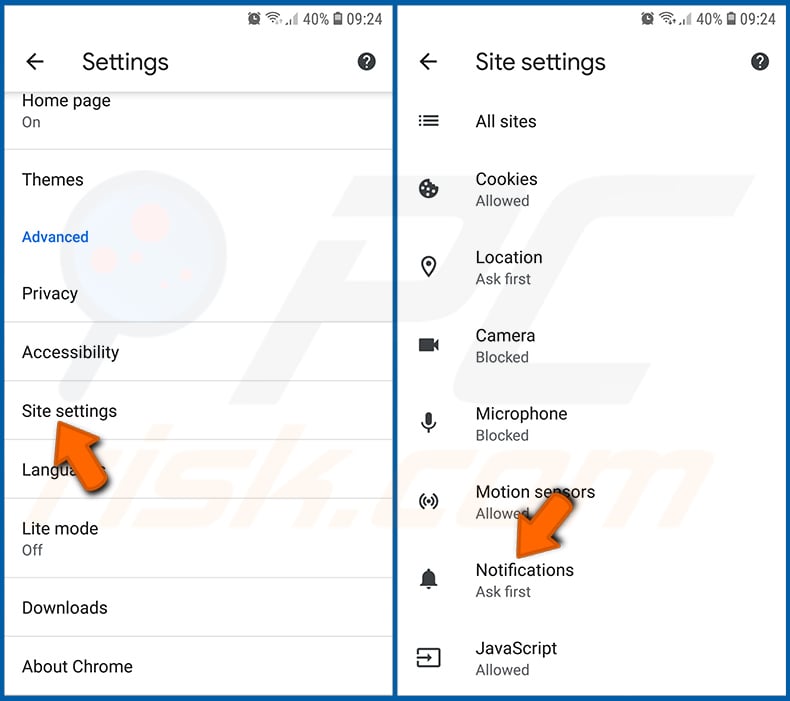
Scroll down until you see "Site settings" option and tap it. Scroll down until you see "Notifications" option and tap it.
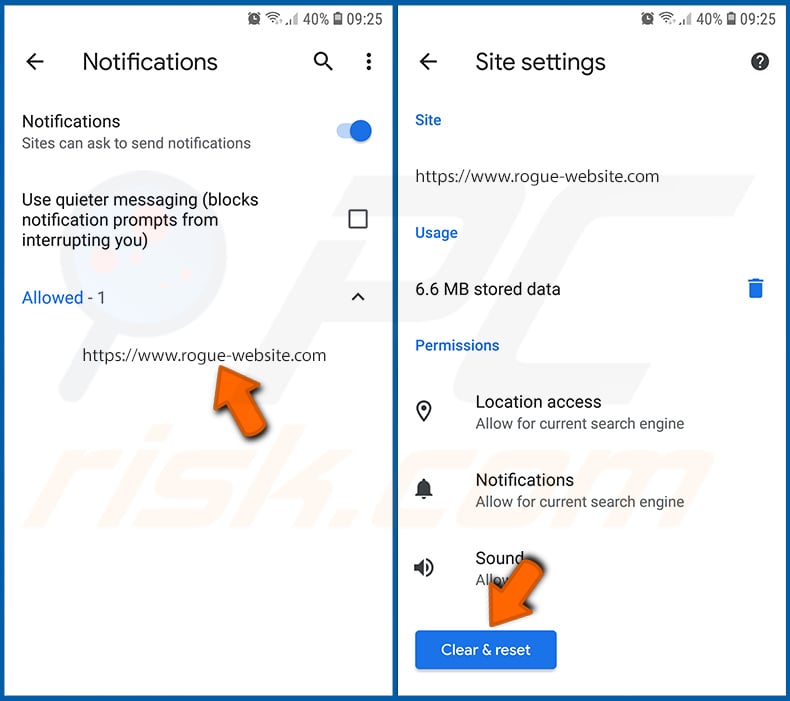
Find the websites that deliver browser notifications, tap on them and click "Clear & reset". This will remove permissions granted for these websites to deliver notifications. However, once you visit the same site again, it may ask for a permission again. You can choose whether to give these permissions or not (if you choose to decline the website will go to "Blocked" section and will no longer ask you for the permission).
Reset the Chrome web browser:
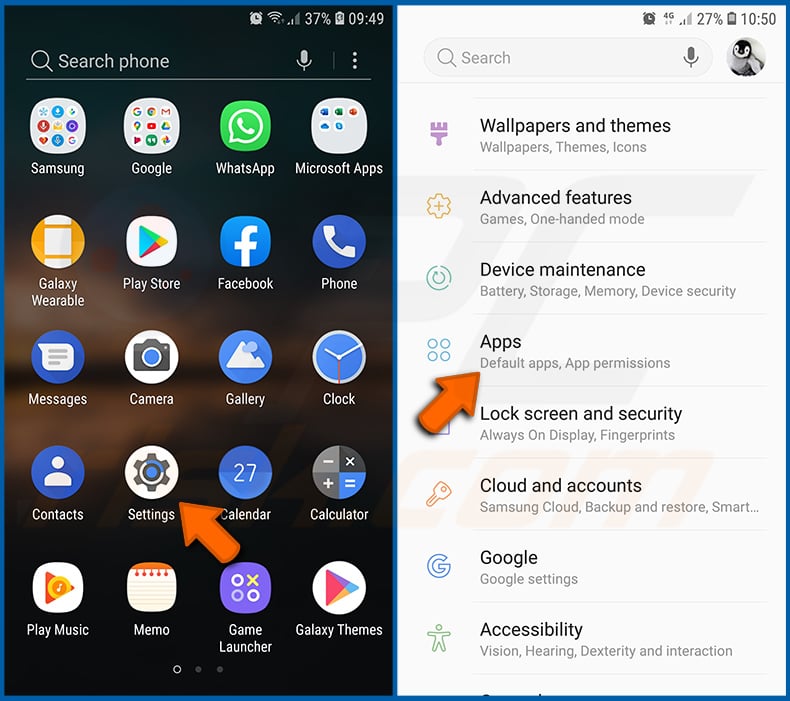
Go to "Settings", scroll down until you see "Apps" and tap it.
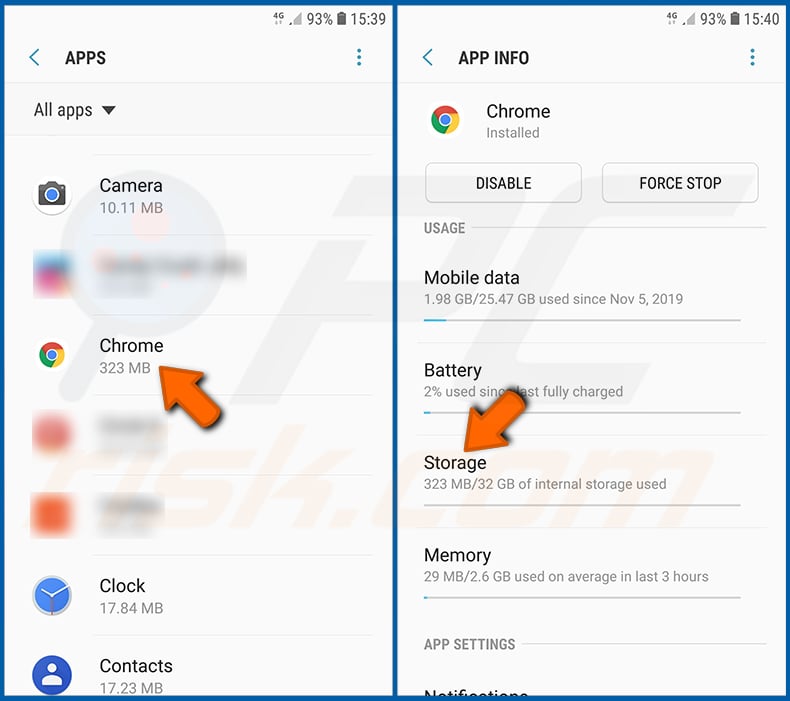
Scroll down until you find "Chrome" application, select it and tap "Storage" option.

Tap "MANAGE STORAGE", then "CLEAR ALL DATA" and confirm the action by taping "OK". Note that resetting the browser will eliminate all data stored within. This means that all saved logins/passwords, browsing history, non-default settings and other data will be deleted. You will also have to re-login into all websites as well.
Delete browsing history from the Firefox web browser:

Tap the "Menu" button (three dots on the right-upper corner of the screen) and select "History" in the opened dropdown menu.
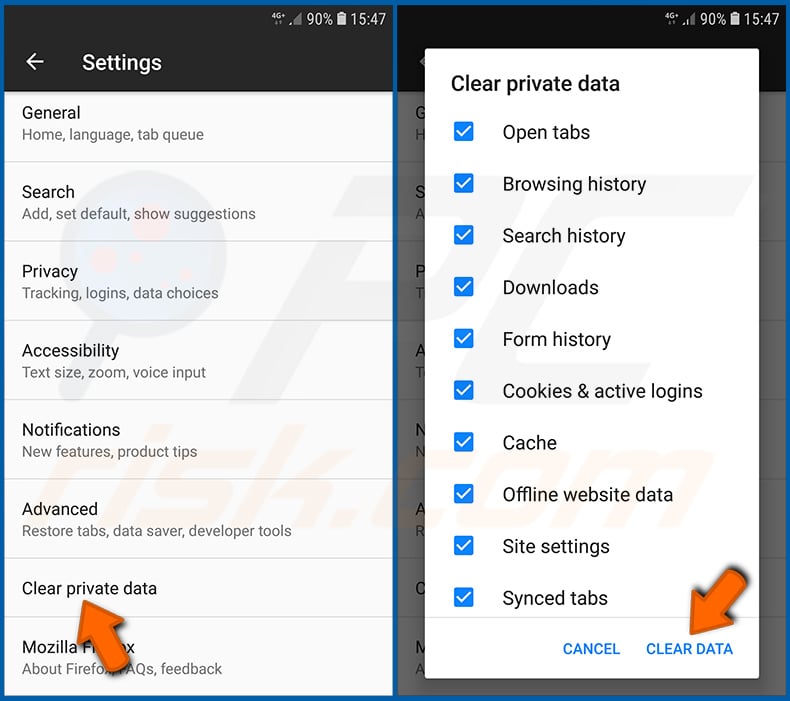
Scroll down until you see "Clear private data" and tap it. Select data types you want to remove and tap "CLEAR DATA".
Disable browser notifications in the Firefox web browser:
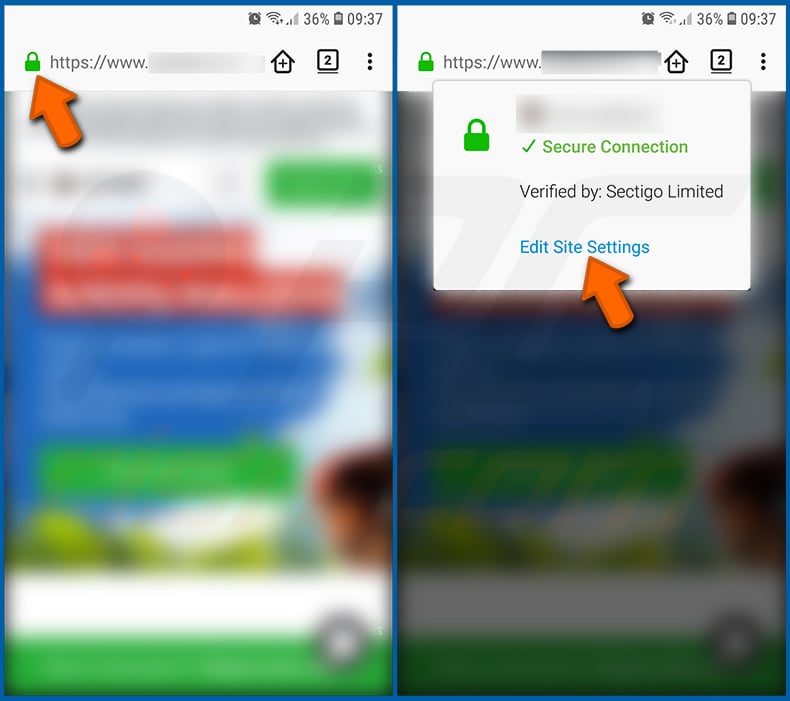
Visit the website that is delivering browser notifications, tap the icon displayed on the left of URL bar (the icon will not necessarily be a "Lock") and select "Edit Site Settings".

In the opened pop-up opt-in the "Notifications" option and tap "CLEAR".
Reset the Firefox web browser:
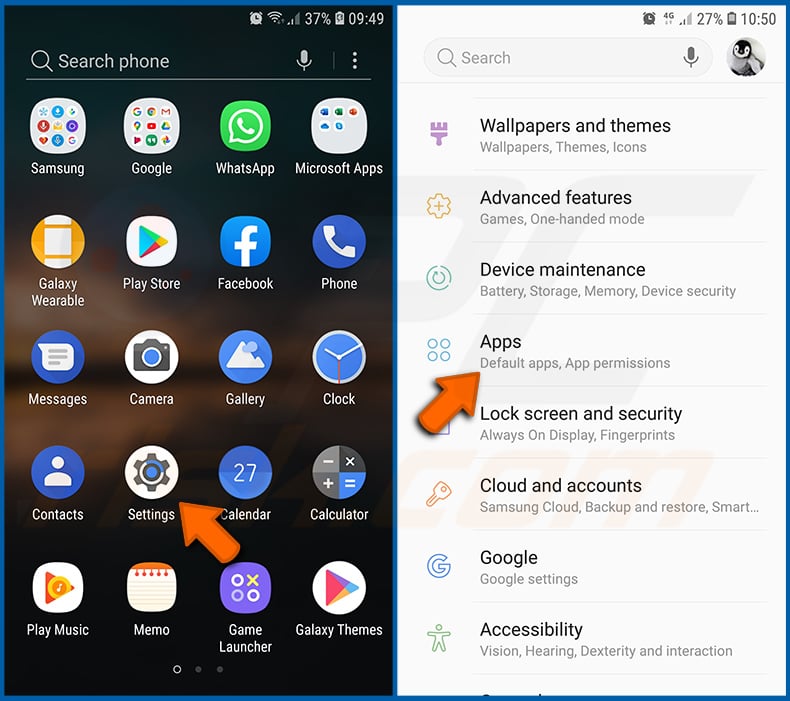
Go to "Settings", scroll down until you see "Apps" and tap it.
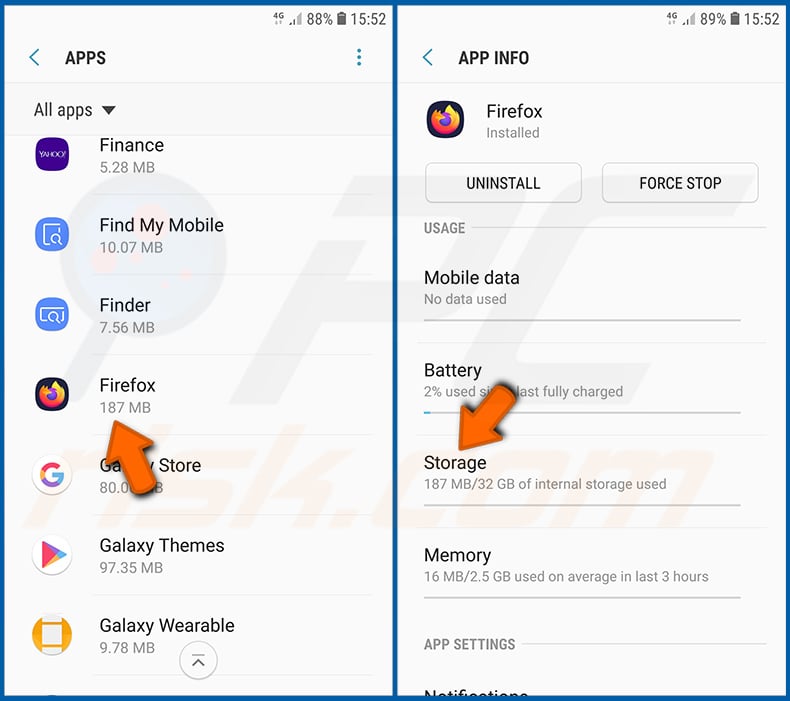
Scroll down until you find "Firefox" application, select it and tap "Storage" option.

Tap "CLEAR DATA" and confirm the action by taping "DELETE". Note that resetting the browser will eliminate all data stored within. This means that all saved logins/passwords, browsing history, non-default settings and other data will be deleted. You will also have to re-login into all websites as well.
Uninstall potentially unwanted and/or malicious applications:

Go to "Settings", scroll down until you see "Apps" and tap it.

Scroll down until you see a potentially unwanted and/or malicious application, select it and tap "Uninstall". If, for some reason, you are unable to remove the selected app (e.g., you are prompted with an error message), you should try using the "Safe Mode".
Boot the Android device in "Safe Mode":
The "Safe Mode" in Android operating system temporarily disables all third-party applications from running. Using this mode is a good way to diagnose and solve various issues (e.g., remove malicious applications that prevent users you from doing so when the device is running "normally").
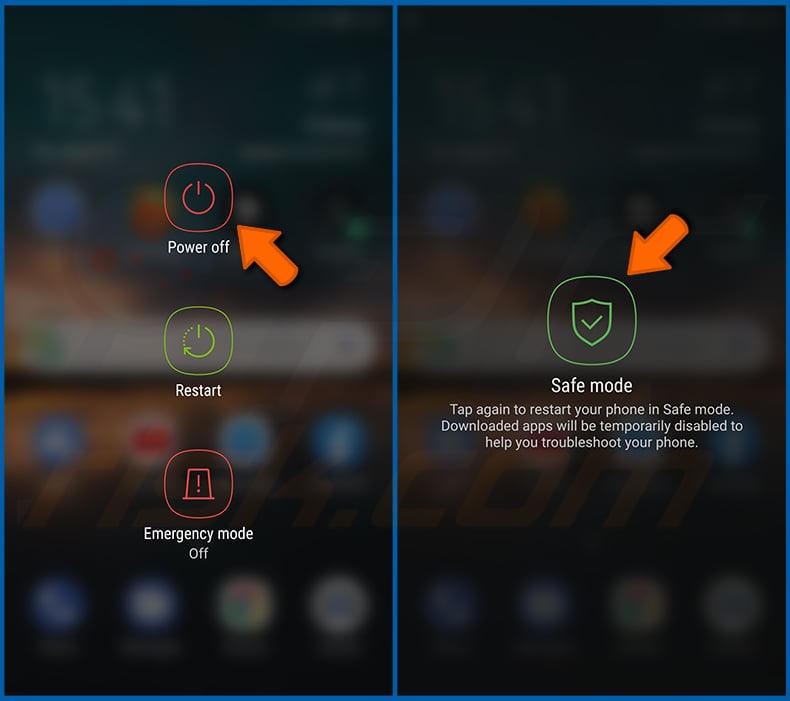
Push the "Power" button and hold it until you see the "Power off" screen. Tap the "Power off" icon and hold it. After a few seconds the "Safe Mode" option will appear and you'll be able run it by restarting the device.
Check the battery usage of various applications:
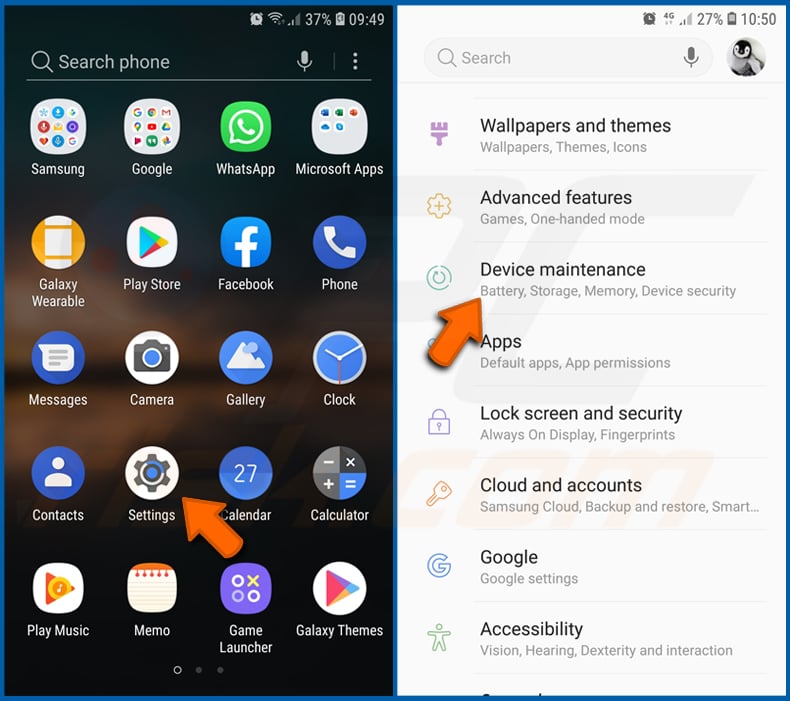
Go to "Settings", scroll down until you see "Device maintenance" and tap it.
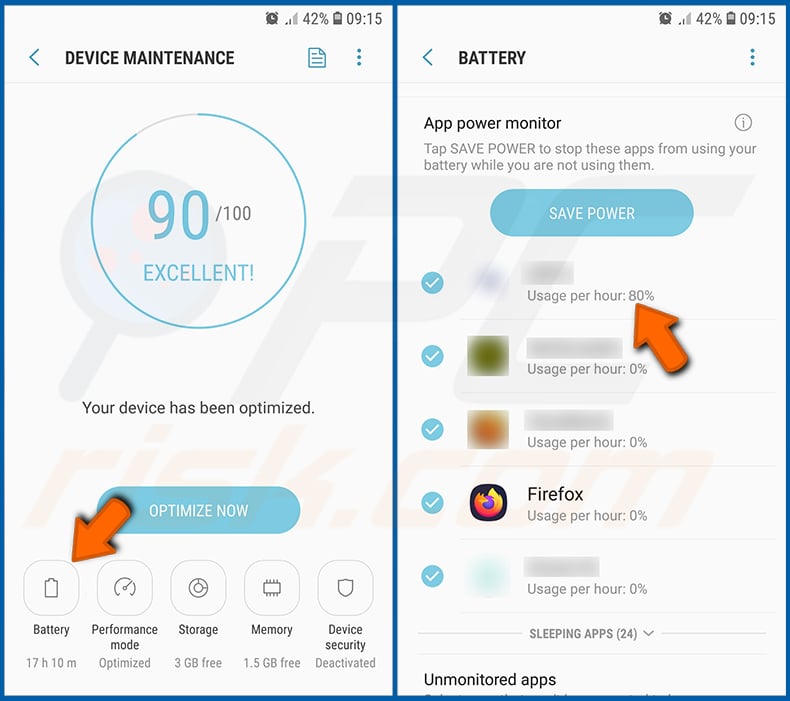
Tap "Battery" and check the usage of each application. Legitimate/genuine applications are designed to use as low energy as possible in order to provide the best user experience and to save power. Therefore, high battery usage may indicate that the application is malicious.
Check the data usage of various applications:
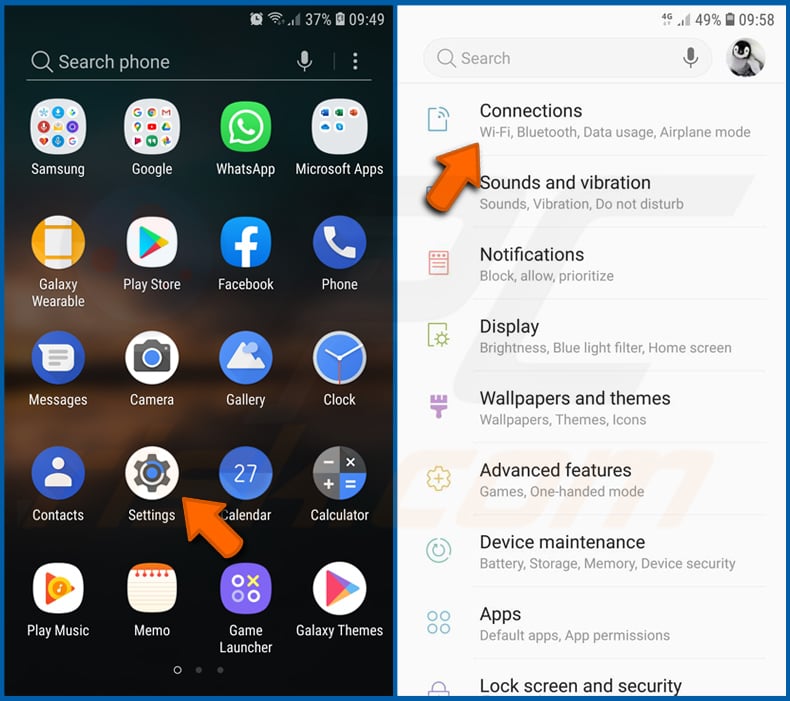
Go to "Settings", scroll down until you see "Connections" and tap it.

Scroll down until you see "Data usage" and select this option. As with battery, legitimate/genuine applications are designed to minimize data usage as much as possible. This means that huge data usage may indicate presence of malicious application. Note that some malicious applications might be designed to operate when the device is connected to wireless network only. For this reason, you should check both Mobile and Wi-Fi data usage.
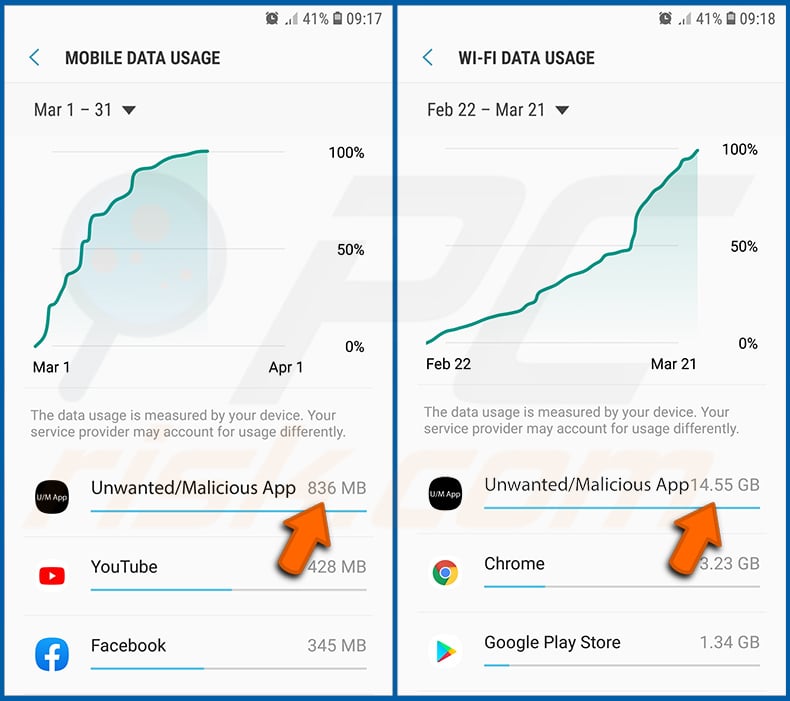
If you find an application that uses a lot of data even though you never use it, then we strongly advise you to uninstall it as soon as possible.
Install the latest software updates:
Keeping the software up-to-date is a good practice when it comes to device safety. The device manufacturers are continually releasing various security patches and Android updates in order to fix errors and bugs that can be abused by cyber criminals. An outdated system is way more vulnerable, which is why you should always be sure that your device's software is up-to-date.
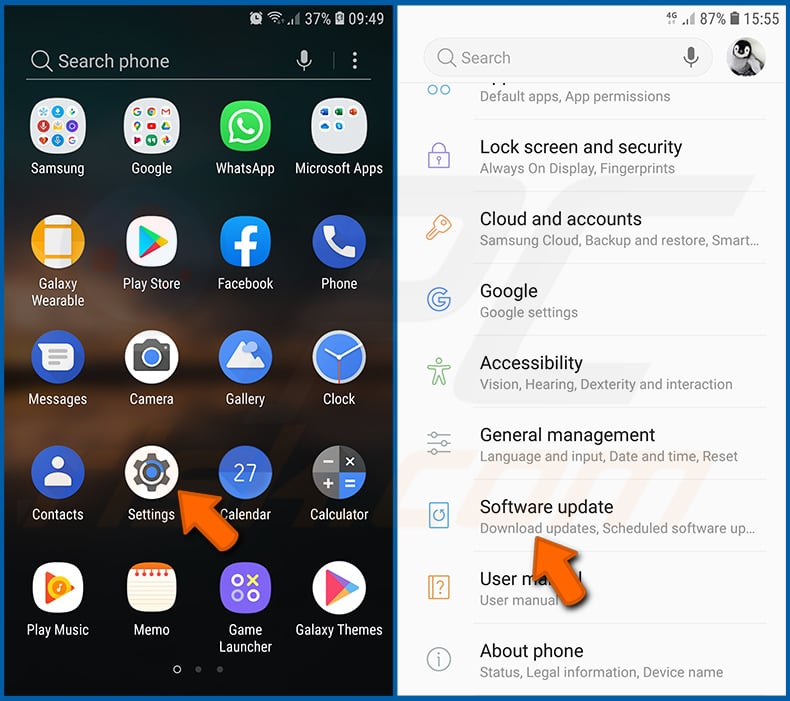
Go to "Settings", scroll down until you see "Software update" and tap it.

Tap "Download updates manually" and check if there are any updates available. If so, install them immediately. We also recommend to enable the "Download updates automatically" option - it will enable the system to notify you once an update is released and/or install it automatically.
Reset the system to its default state:
Performing a "Factory Reset" is a good way to remove all unwanted applications, restore system's settings to default and clean the device in general. However, you must keep in mind that all data within the device will be deleted, including photos, video/audio files, phone numbers (stored within the device, not the SIM card), SMS messages, and so forth. In other words, the device will be restored to its primal state.
You can also restore the basic system settings and/or simply network settings as well.
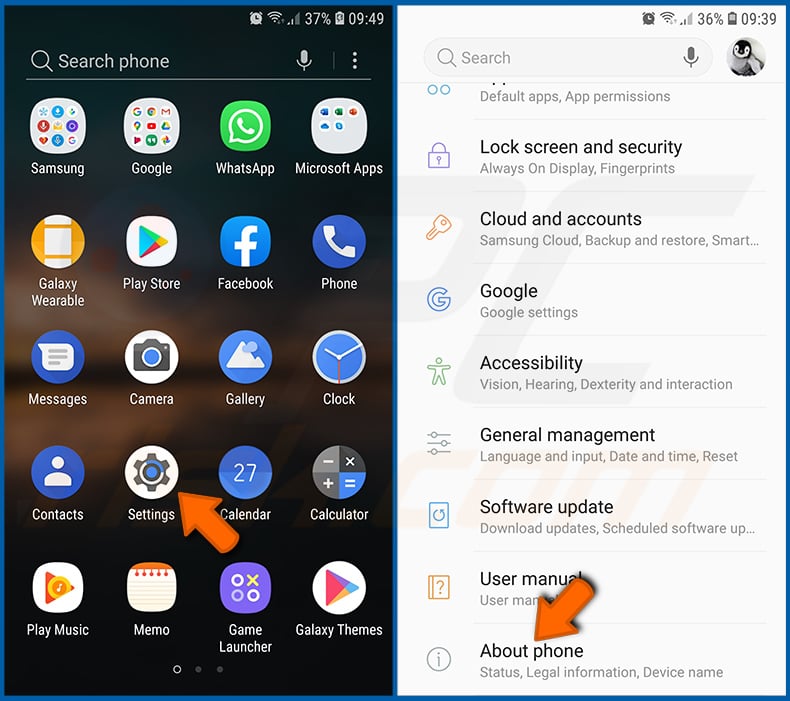
Go to "Settings", scroll down until you see "About phone" and tap it.
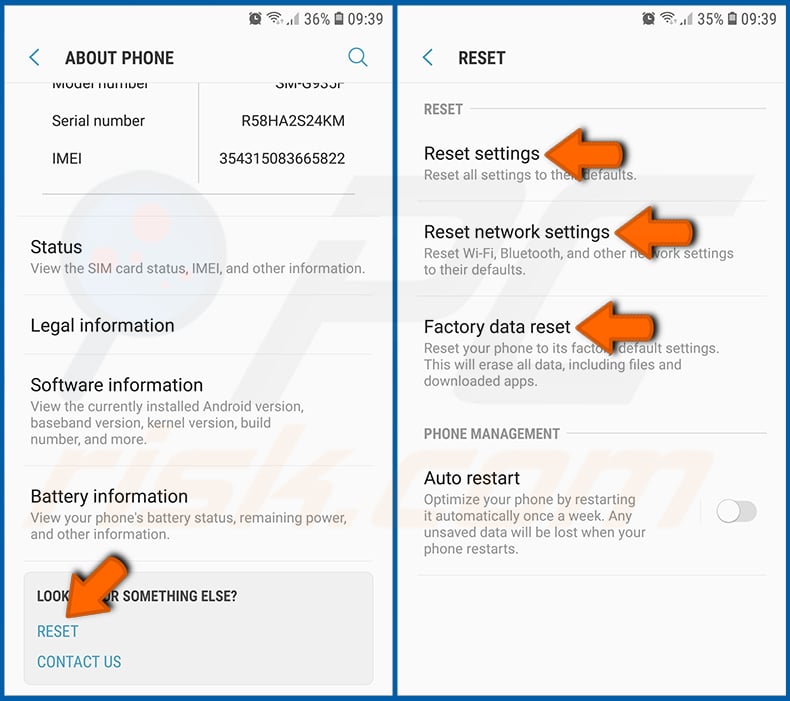
Scroll down until you see "Reset" and tap it. Now choose the action you want to perform:
"Reset settings" - restore all system settings to default;
"Reset network settings" - restore all network-related settings to default;
"Factory data reset" - reset the entire system and completely delete all stored data;
Disable applications that have administrator privileges:
If a malicious application gets administrator-level privileges it can seriously damage the system. To keep the device as safe as possible you should always check what apps have such privileges and disable the ones that shouldn't.

Go to "Settings", scroll down until you see "Lock screen and security" and tap it.

Scroll down until you see "Other security settings", tap it and then tap "Device admin apps".
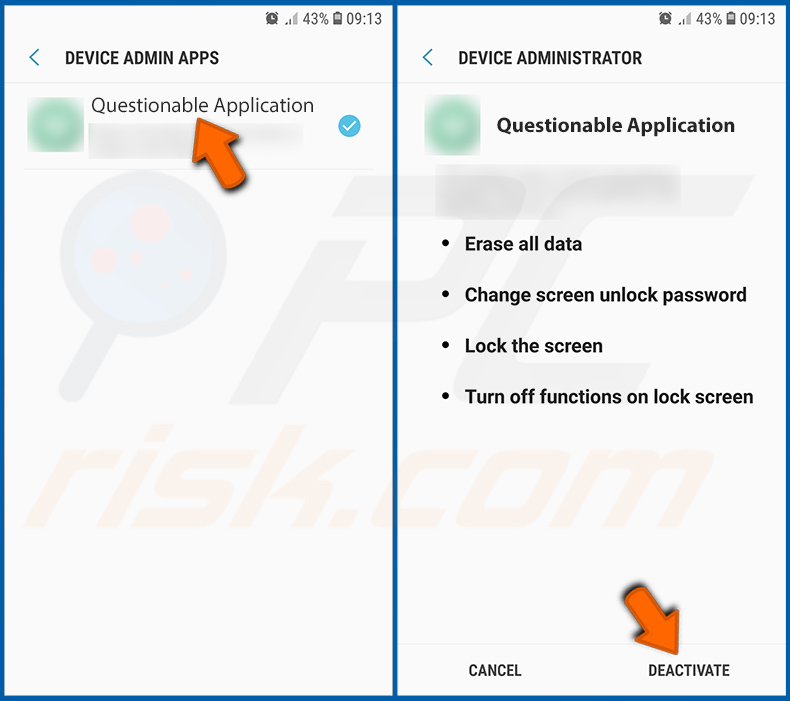
Identify applications that should not have administrator privileges, tap them and then tap "DEACTIVATE".
Frequently Asked Questions (FAQ)
My device is infected with Fantasy Hub malware, should I format my storage device to get rid of it?
You can remove Fantasy Hub by factory resetting the device (formatting it), but this will delete all your data. As a safer option, you can scan and clean the device using a trusted antivirus app like Combo Cleaner.
What are the biggest issues that malware can cause?
Malware can steal personal details (e.g., passwords or banking details), give attackers remote access, damage systems, inject additional malware, encrypt files, and ultimately lead to financial loss, identity theft, data loss, and other problems.
What is the purpose of Fantasy Hub?
The purpose of Fantasy Hub is to give attackers full remote control over infected Android devices. It can steal sensitive data (SMS, contacts, call logs, photos, videos), spy via the camera and microphone, display fake banking apps to harvest credentials, perform phone actions (calls, USSD codes), monitor device sensors, and hide or erase itself.
How did Fantasy Hub infiltrate my device?
Attackers trick users with convincing fake app pages (mainly Google Play sites) and offer repackaged APKs that look legitimate. When you install one, a hidden installer inside the app unpacks the malicious payload and activates the malware.
Will Combo Cleaner protect me from malware?
Combo Cleaner can find and remove most malware, but some advanced threats may hide deep in the system. Running a full device scan ensures the malware is completely removed without leaving any traces behind.
Share:

Tomas Meskauskas
Expert security researcher, professional malware analyst
I am passionate about computer security and technology. I have an experience of over 10 years working in various companies related to computer technical issue solving and Internet security. I have been working as an author and editor for pcrisk.com since 2010. Follow me on Twitter and LinkedIn to stay informed about the latest online security threats.
PCrisk security portal is brought by a company RCS LT.
Joined forces of security researchers help educate computer users about the latest online security threats. More information about the company RCS LT.
Our malware removal guides are free. However, if you want to support us you can send us a donation.
DonatePCrisk security portal is brought by a company RCS LT.
Joined forces of security researchers help educate computer users about the latest online security threats. More information about the company RCS LT.
Our malware removal guides are free. However, if you want to support us you can send us a donation.
Donate
▼ Show Discussion